

The East Memorial Building and West Memorial Building are a pair of government buildings in Ottawa, Ontario, Canada.


The East Memorial Building and West Memorial Building are a pair of government buildings in Ottawa, Ontario, Canada.
Construction started in 1949 to house the rapidly growing Department of Veterans Affairs. The buildings were thus originally named the Veterans Memorial Buildings. They were designed by George Roper Gouinlock (son of architect George Wallace Gouinlock) and H.L. Allward and appears to be a stripped down Art Deco style.
The National Capital Commission (NCC) in collaboration with Public Works and Government Services Canada erected a historical plaque:
East and West Memorial Buildings - For those who served. In the 1950s, Canada erected the twin Memorial Buildings on Wellington Street. One of those buildings, at the time housed the new Department of Veterans Affairs. In the 20" century alone, nearly two million Canadians served their country in war. Now Canada serves these people through the Veterans Charter, a pact exceptional in the world for the breadth and scope of services it offers.
At the end of the Second World War in 1945, Canada was determined to help veterans, but it faced an enormous challenge in integrating hundreds of thousands of returning servicemen and servicewomen into Canadian society. The answer was a brilliant array of educational, health, housing and employment programs.
Honouring a generation - The memorial Buildings, erected in 1949 and 1955 respectively, were designed with a sleek melding of neoclassical and copper-roofed chateau styles. The buildings are unusual in that they are linked by the memorial Arch, which is not really an arch at all, but a bridge. The Memorial Arch is dedicated to all who served in the Second World War.
A feat of arms - In April 1945, Canadian troops crossed the Rhine and pushed north to liberate the Netherlands from five long years of occupation. As Canadian tanks rolled into one Dutch town after another, the people went wild with joy and took to the streets in celebration.
Returning to Canada, those who served from 1939 to 1945 were honoured with the title of "veterans" and the gratitude of all Canadians. The Canadian government helped thousands of veterans like Stanley Lolley- a survivor of two World Wars- to get an education or establish businesses. Edward Dunlop of the Queen's Own Rifles was blinded in 1943 while saving others from a grenade explosion and he received the George Medal for valour. He was later active in the rehabilitation of disabled veterans and was awarded the Order of the British Empire for that work.
A memorial is dedicated to the memory of 1701 Men of the Canadian Bank of Commerce who served in the Great War. [1] The buildings are located on the south side of Wellington Street, across the street from the Supreme Court of Canada Building. Lyon Street passes between the two buildings, but they are linked by the Memorial Arch. Between the two lanes of Lyon Street are gardens and a large stone relief carved by Ivan Meštrović to honour those who fought in the Second World War.
In the early 1980s, as part of Prime Minister Pierre Elliot Trudeau's plans to decentralize the federal government, Veterans Affairs' headquarters moved out of the East Memorial Building and into the Daniel J. MacDonald Building in Charlottetown, Prince Edward Island. Other departments have since moved in. Today the Department of Justice is headquartered in the East Building. Currently, West Memorial Building is vacant and in poor condition with plans for major renovations in the near future. 1 Some offices for the National Archives were also located in these buildings.
The West Memorial Building will be renovated from 2019-2023 to restore it to a usable condition. From 2023-2028 it will house the Supreme Court of Canada, Federal Court of Appeal, and the Federal Court. [2]

Parliament Hill, colloquially known as The Hill, is an area of Crown land on the southern bank of the Ottawa River in downtown Ottawa, Ontario, Canada. It accommodates a suite of Gothic revival buildings whose architectural elements were chosen to evoke the history of parliamentary democracy. Parliament Hill attracts approximately three million visitors each year. The Parliamentary Protective Service is responsible for law enforcement on Parliament Hill and in the parliamentary precinct, while the National Capital Commission is responsible for maintaining the nine-hectare (22-acre) area of the grounds.

Queen's Park is an urban park in Downtown Toronto, Ontario, Canada. Opened in 1860 by Edward, Prince of Wales, it was named in honour of Queen Victoria. The park is the site of the Ontario Legislative Building, which houses the Legislative Assembly of Ontario. The phrase "Queen's Park" is regularly used as a metonym for the Government of Ontario or the Legislative Assembly of Ontario.

A war memorial is a building, monument, statue, or other edifice to celebrate a war or victory, or to commemorate those who died or were injured in a war.

Exhibition Place is a publicly owned mixed-use district in Toronto, Ontario, Canada, located by the shoreline of Lake Ontario, just west of downtown. The 197-acre (80 ha) site includes exhibit, trade, and banquet centres, theatre and music buildings, monuments, parkland, sports facilities, and a number of civic, provincial, and national historic sites. The district's facilities are used year-round for exhibitions, trade shows, public and private functions, and sporting events.
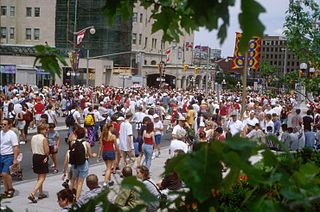
Wellington Street is a major street in Ottawa, Canada. It is notable for being the main street of the Parliamentary Precinct of the Parliament of Canada. It is one of the first two streets laid out in Bytown in 1826. The street runs from Vimy Place, just west of Booth Street, to the Rideau Canal where it connects with Rideau Street and delimits the northern border of the downtown core. It is named after the Duke of Wellington, in recognition of his role in the creation of the Rideau Canal, and therefore of Ottawa.

The California State Capitol Museum consists of a museum in and grounds around the California State Capitol in Sacramento, California, United States. The building has been the home of the California State Legislature since 1869. The State Capitol Museum has been a property in the California State Parks system since 1982.

The Drill Hall at Cartier Square is a dedicated military training facility in Ottawa, Ontario, Canada. It has been a local landmark since its construction in 1879. The drill hall is 70 metres (230 ft) long and has two 43-metre-tall (141 ft) mansard towers.
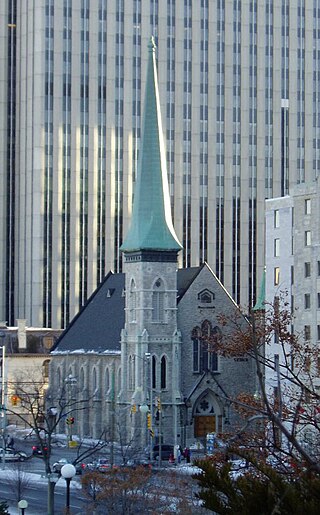
First Baptist Church is a Baptist church in Ottawa, Ontario, Canada. It is affiliated with the Canadian Baptists of Ontario and Quebec.

The current Ottawa City Hall is the city hall of Ottawa, Ontario, Canada. The downtown complex consists of two connected buildings: a modern wing located on Laurier Avenue and a 19th-century heritage wing located on Elgin Street. Although City Hall has frontage on two major streets, the main entrance is on Laurier Avenue, and the municipal address is 110 Laurier Avenue West.
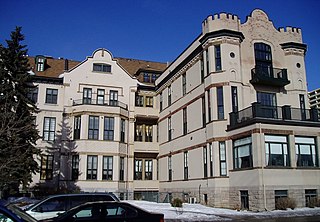
Wallis House is a prominent landmark building in Ottawa, Ontario, Canada. It is located at the corner of Rideau Street and Charlotte Street. Today, after restoration, the building serves as a deluxe condominium complex.
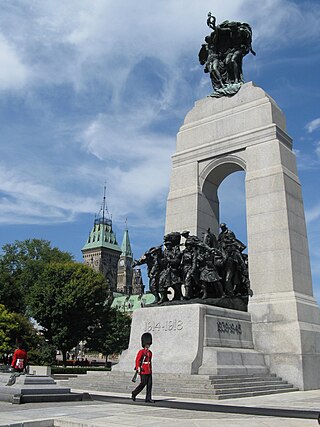
The National War Memorial, titled The Response, is a tall, granite memorial arch with accreted bronze sculptures in Ottawa, Ontario, designed by Vernon March and first dedicated by King George VI in 1939. Originally built to commemorate the Canadians who died in the First World War, it was in 1982 rededicated to also include those killed in the Second World War and Korean War and again in 2014 to add the dead from the Second Boer War and War in Afghanistan, as well as all Canadians killed in all conflicts past and future. It now serves as the pre-eminent war memorial of 76 cenotaphs in Canada. In 2000, the Tomb of the Unknown Soldier was added in front of the memorial and symbolizes the sacrifices made by all Canadians who have died or may yet die for their country.

Christ Church Cathedral is the Anglican cathedral in Ottawa, Ontario, Canada. The church is located at 414 Sparks Street in the northwest section of the city's downtown at the western end of Sparks Street on top of a promontory looking down to the Ottawa River.

Confederation Park(French: Parc de la Confédération) is a public park and National Historic Site of Canada, located in the downtown core of Ottawa, Ontario, Canada. It is bordered on the south by Laurier Avenue and Ottawa City Hall; on the east by the Rideau Canal and National Defence Headquarters; on the north by the Mackenzie King Bridge, the Rideau Centre and the National Arts Centre; and to the west by Elgin Street and the Lord Elgin Hotel.

The Etobicoke Civic Centre in the Eatonville neighbourhood of Toronto, Ontario, Canada, once housed the municipal government of the former City of Etobicoke.

Sunnybrook Health Sciences Centre (SHSC), commonly known as Sunnybrook Hospital or simply Sunnybrook, is an academic health science centre located in Toronto, Ontario, Canada. It is the largest trauma centre in Canada and the only accredited Level 1 trauma centre outside of the US. Sunnybrook is a teaching hospital fully affiliated with the University of Toronto. The hospital is home to Canada's largest veterans centre, in the Kilgour Wing and the George Hees, which cares for World War II and Korean War veterans.
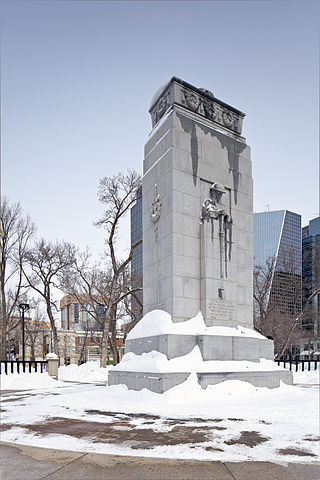
Victoria Park is a public park in the centre of downtown Regina, the capital of the Canadian province of Saskatchewan.

The Beatty Street Drill Hall is a Canadian Forces armoury located at 620 Beatty Street in Vancouver, British Columbia. It is the home of The British Columbia Regiment, an armoured reconnaissance reserve regiment, the oldest military unit in Vancouver, and the most senior militia in the province.

St. John the Evangelist Anglican Church is an Anglican church in downtown Ottawa, Ontario, Canada, at the corner of Elgin and Somerset streets.
The Plaza Bridge in Ottawa, Ontario, Canada, is an automotive and pedestrian bridge that crosses the Rideau Canal just south of the Ottawa locks. It joins Wellington Street and Elgin Street in the Downtown core to the west with Rideau Street to the east. The Chateau Laurier abuts the bridge at the east end, while Parliament Hill is just beyond the west end. It is the northernmost bridge over the canal, just north of the Mackenzie King Bridge.

The Memorial to the Victims of Communism – Canada, a Land of Refuge is a monument that as of November 2023 is currently under development in Ottawa, Ontario, Canada. Its official unveiling was to have occurred on November 2, 2023 but has been delayed as a result of the Yaroslav Hunka scandal and concerns that the names of Waffen SS members and other Nazi collaborators have been submitted for recognition, as well as other concerns.